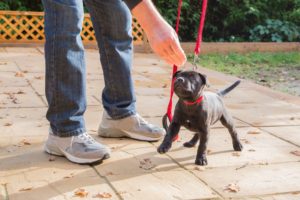
Many trainers will tell you to wait for formal obedience until a puppy is 4 to 6 months old. I agree that punishments before 4 months could be detrimental and create neurotic behaviors in dogs. That being said, I would argue that whether it is intentional or not, we are training our dogs with every single interaction. For instance, if my new puppy doesn’t want to go into her crate at night and barks and whines to the point that I finally let her out, I have taught her that barking and whining will win her freedom. Now, I didn’t intentionally teach my puppy this, I just wanted to keep her quiet so my human kids could sleep. So, the puppy will continue to fuss until I either let her out or she gives up. If I wait till she is quiet to let her out, I have taught her that being quiet will earn her freedom.
Another example would be a dog that shows leash aggression. Many times leash aggression is exhibited because the dog wants to escape the situation whether it be a stranger or another dog. Most owners I’ve worked with, as soon as their dog shows leash aggression will whisk the dog away to safety. Now, in this situation the owner is just trying to get out of an uncomfortable situation (as is the dog), but what the dog is learning is that if she acts aggressively, either she will be removed from the situation or the stranger or other dog will be removed. So, the next time the dog is faced with a similar situation, the dog will act even more aggressively if the stimulus isn’t removed. This is often what causes the behavior to worsen because the source of stress can’t always be avoided.
I have one last example. Have you ever seen someone trying to catch a dog that has either door crashed, slipped a leash or somehow escaped from their owner. Many times, the owner will be yelling at the dog and once the dog finally comes, the owner scolds the dog. In this situation, the dog has learned that coming when called is bad. Again, the owner didn’t mean to teach this to their dog, but nevertheless trained their dog to do the opposite of what the owner wanted. I see this situation literally every time I visit a dog park.
My point is we are always training our dog either good or bad, we are teaching and they are learning. It is critical that owners recognize this fact and interact with their pet in a responsible manner with a focus on proper training. Here are some tips I give all of my clients that will help to ensure that you are communicating with their dogs in a productive and mutually beneficial way.
Tips for training:
- All dogs should learn sit, stay, down, come and heel
- Never interact with a dog that rewards bad behavior
- This includes chasing your dog. I never want a dog to run from me, ever!
- Rough play that causes a dog to jump on you or put their mouth on you.
- If a dog is ever allowed to do something once, then in their mind they are always allowed to do it . For example, if a dog is allowed on the bed once, then they are always allowed. if you aren’t ok with the dog on the bed, then never allow the dog on the bed.
- If you give your dog a command then, they must obey. Even if it is 3am and you tell your dog to sit. If they don’t obey, you must get up and make the dog comply.
- When training, handlers only have 2-4 seconds to reward or correct behavior. Any more time than that and the dog can not make the connection between the behavior and the reward or consequence.
- Train everyday.
- All training should begin with a positive reinforcement program. Dogs should not be corrected until they have a firm understanding of the command.
- Train for every situation your dog may face. For instance, I hear people say all the time “My dog can sit, stay, down and come.” My response is always “Will your dog sit and stay in the middle of the dog park”. Usually they look at me like that would be impossible. The truth though is simple, if a dog can’t obey a command when it is absolutely necessary with heavy distractions, then the dog can’t really do it.
- Face uncomfortable situations. I’m not suggesting putting your dog aggressive dog in a dog park. I’m suggesting, train for the uncomfortable situations in a controlled setting. So that when the situation isn’t within your control, the dog has had the appropriate exposure and training.
- If you don’t have the time, experience and patience to train your pet, hire a professional trainer. Especially if the dog is showing signs of aggression.
I sincerely hope this post helps someone out there,
John Holland
